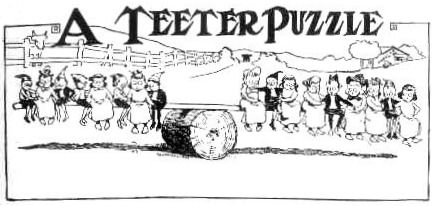



Elementary Lessons in Algebra
If all of those little boys were seated on one arm of the see saw, how many girls would it require on the other end to keep the balance even?
A teeter-tater illustration gives a clearer idea of the algebraic meaning of the two sides of an equation than could be acquired from months of hard study. Let us illustrate the first principle of algebra which tells us that like quantities added or subtracted from both sides of the balance do not change the equilibrium. We will solve the puzzle by the principle of cancellation. There are five boys on one arm of the balance and three on the other, so we cancel off three from each end. Then as there are three girls on one end and six on the other, we will cancel off three from both sides so as lo leave two boys balancing with three girls. Startling as it may look, we find that two of those little boys weigh the same as three girls, so if the eight little boys were placed on one arm of the see-saw it would require twelve of the fat girls to balance them! You see to make the picture deceptive the little boys were tilled with lead,
7. A Charade
My first, gentle lady, you give to the youth
Who now breathes the fond wish of his soul;
Whom with ardent affection, and honor and truth,
You perceive is needed in my whole.
In my snug little second, secure from the storm,
We the helpless and innocent find ;
And my whole, when a contract or bargain you form,
You should give, the agreement to bind.
Cipher Answer.— 5, 1, 18, 14, 5, 19, 20.
EARNEST
8. A Puzzle
Express with four letters a sentence of four words containing fourteen letters.
Ans. — I O U O.
[I owe you nothing. — jws]
10. A Charade
Perhaps you may know
That centuries ago
My name the world was unknown;
But now 'tis allow'd
In the midst of a crowd
I am met with in every town
Though varied each lot,
In life I have got,
Yet nothing my course e'er endangers ;
And wherever I go
So familiar I grow
That I am nodded to even by strangers.
I am cunning and bold.
For young or for old
I fear not, but bawl out aloud;
Pugnacious, you'll say,
For I knock down by scores in a crowd.
I lie and mislead,
So I pray you take heed;
My art's like a point of a thistle;
Be nice in your choice,
Take Franklin's advice,
And don't pay too much for your whistle.
Cipher Answer.— 1, 21, 3, 20, 9, 15, 14, 5, 5, 18.
AUCTIONEER
11. A Rebus
In every hedge my second is,
As well on every tree.
And when the schoolboy acts amiss,
It often is his fee.
My first, likewise, is always wicked,
Although it does no sin.
My total for my first is fitted,
Is made of brass or tin.
Cipher Answer.—3, 1, 14, 4, 12, 5, 19, 20, 9, 3, 11.
CANDLESTICK
12.

To show how little the patrons of the turf know about the theory of odds as practiced at the race track, let readers seek a solution to the following elementary problem: If the odds are 7 to 3 against Apple Pie and 6 to 5 against Bumble Bee. What should be the odds against the famous running horse Cucumber?
If the odds are 7 to 3 against Apple Pie, then we receive back $10 for an outlay of $3; or would get back $11 for an outlay of $5 on Bumble Bee. Therefore to balance the book we must place $27 to $83 on Cucumber, as proven by the following: $33 on A would bring $110, or $50 on B would bring $110, and $27 to $83 on C would bring $110. So if you place $33, $50 and $27, which amounts to $110, no matter which horse wins you just get your $110 back.
[Page 13]